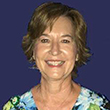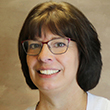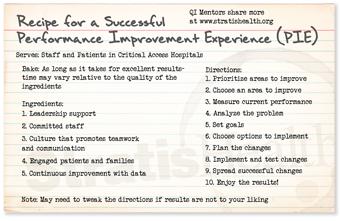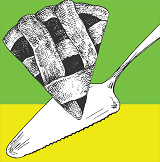“We have found that hourly rounding has been very, very, beneficial and our nurses are required to make sure it’s documented in the record so that we can have our checks and balances. Because just like anything else, if you don’t monitor it, it probably is not going to happen.”
December 2021
In this session of Quality Time: Sharing PIE, Mentors Karen Hooker from Melissa Memorial Hospital in Holyoke, Colorado, and Brenda Stevenson from Titusville Area Hospital in Titusville, Pennsylvania, share some of the ways that staff at their facilities routinely engage patients and families in the care process.
Want to take Quality Time with you on the go? You can subscribe to the podcast version through your favorite streaming service.
Second helping of PIE?
If you would like more information
from the national virtual Quality
Improvement Mentors on their
performance improvement
experience in critical access
hospitals, please submit this
short form.
| QI Mentor favorite featured pie recipe: Chocolate Dream Pie |
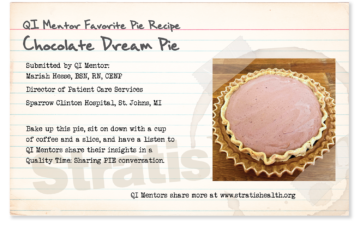 |
Transcript: Patient and Family Engagement
Note: Quality Time: Sharing PIE is produced for the ear and designed to be heard. This transcript is intended to augment the recording.
Narrator: In this session of Quality Time: Sharing PIE, Mentors Karen Hooker from Melissa Memorial Hospital in Holyoke, Colorado, and Brenda Stevenson from Titusville Area Hospital in Titusville, Pennsylvania, share some of the ways that staff at their facilities routinely engage patients and families in the care process.
Brenda: One of the things that we do, we have started, a bedside shift report. We’ve had a little bit of pushback from some of the nurses. So, we pulled in one of our nurses who was more vocal and had her involved and still have her involved as far as, learning about family engagement, patient engagement, and then she’s taken that back to the other staff and answering those questions and really it seems to be going very well.
Brenda: And another thing we’ve been doing is education clipboards that are in the patients’ rooms. So, the patients and the family can take a look at that, see what education is important for them to learn on going home and being able to care for themselves. And also, any staff member, whether it’s nursing, lab, quality, whoever may go in, social service, can also take that clipboard and see what the patient’s learning and document as far as what level they’re at, their understanding, whether they need more education on a particular part. So, it kind of alerts everybody that there is education on the clipboard.
Karen: Those sound like some good ideas with the bedside reporting and the communication board. And it seems to be working well with your, your patients? They seem to be engaged in that.
Brenda: Absolutely, say we’re talking about, in, um, insulin then they can go to the insulin information and review that so they know that that’s what they’re going to be taught today, and they can already have questions in mind, there’s places where they can actually, you know, write some questions down so they can remember to ask the nurse. So, it’s kind of a give and take, which seems to be working pretty well right now.
Karen: So, my organization hasn’t embraced the bedside shift reporting but we did embrace the hourly rounding and we found that that, has really reduced the amount of call light usage. Hourly rounding they go over the four P’s which would be their potty, positioning, possession, and pain. And by doing that, it just seems like the patient is more, they rest easy knowing that someone’s there, that someone will take care of them and that we are really concerned about their comfort.
Karen: So, we have found that hourly rounding has been very, very, beneficial and our nurses are required to make sure it’s documented in the record so that we can have our checks and balances. Because just like anything else, if you don’t monitor it, it probably is not going to happen. Sometimes the nurse’s aide will do the hourly rounding and then report to the nurse, so it’s, truly a team initiative to make sure the patient has what they need. So, we have found that to be very beneficial and it seems like it’s being reflected in our HCAHPS scores as patients feel like they’re being cared for.
Brenda: We do, the hourly rounds too but we only do the 3 P’s which is potty, position, and pain, so possession is great, and I am in charge of our falls committee, and that’s one of the things that we talk about, everything’s close for the patient to reach, and so yeah, adding a, a fourth P, wonderful idea.
Karen: It really does work because everybody has a cellphone. And it does no good if they have a cell phone that’s plugged into the wall, that’s you know, seems like 20 miles away from their bed, it’s really not but it feels that way to the patient. So, it’s like, it’s, it’s so important that they have that, their possessions.
Karen: The other thing that we really try to work on is training for our staff on how to communicate with patients, we believe that it’s important to train the staff in how to communicate with the patient using that therapeutic communication. And that’s not something that everybody has, so we actually train, and we try to ensure that they have the skill set they need to communicate with their patients.
Brenda: Do you have formal training for that or do have just somebody that…
Karen: So, we’re just kicking this off. And so, as we continue to develop it then we will have more formal-type training and checkoffs.
Narrator: We asked the Mentors about the different ways their organizations gather feedback from patients and families about their experience, and how they use that information to inform their improvement efforts.
Brenda: At Titusville, in our ER, we do real-time surveys. Patients get an iPad and are asked to fill the survey out or complete it, you can get all the reports and stuff, but you can get actual feedback from the patients, they can list specific staff if they’ve done a wonderful job or a not so, so wonderful job. And all that information is shared with the department manager and with the staff themselves.
Brenda: We give prizes for different pop-up, I call them pop-up races or events. So, i- if somebody has 100% on informing the patient of wait times. That could be a pop-up and they’ll get a prize. It could be a traveling trophy. And we also do phone calls for HCAHPS surveys, done with an outside company. But I get to hear any and, or all of the responses, and those verbal responses can actually be shared with staff also, or I can get a transcript which gets shared with staff.
Brenda: We do do 100% follow-up phone calls of all of our discharged patients, whether they’re observation or inpatient and any of those comments will get also shared with staff and leadership and, we try to get them done within one to two days of discharge, we can answer any questions that they may not have thought about when they were in the hospital when they got home and realized, hmm, I really didn’t understand that, or I thought I did and now I don’t know where I’m supposed to be going, when. It really does improve our HCAHPS because we’re reaching out and really making sure that they understand.
Karen: We only use our certified Medicare vendor to gather our surveys. But the vendor that we’re using we can actually capture that data pretty close to real-time because it’s always available by running the reports. So, I have started running the report with the comments and putting that into my quality report. And then, since this is a new process for me, I have written the thank-you notes to the individuals that are specifically listed in the survey.
Karen: So, the card, the thank you note, or the card will be sent to the employee’s home, with the exact words of what the patient said about them and then words of, you know, thank you for taking care of our patients and making them feel right at home, or something like that. And then signing it. My end goal would be to have the board members sign the card with me or without me because that will carry more weight.
Karen: If you do look at the comments and do them on a monthly basis, you can glean a lot of what’s going on and with your hospital and your community and what they’re thinking and so you can be more proactive in what you’re doing as far as the changes that you’re making
Narrator: The Mentors shared some other ways they gather feedback from and engage their communities.
Karen: We do have a patient-family advisory council and there are two board members that actually sit on that council with our community members, and so that hospital gives it more credibility. We have diversity on our group so then we can truly hear the voice of the patient or the family or the visitor so we can hear their voice, which is our full intent. They are actively engaged with the different surveys that we have to do, whether it’s a community needs assessment or if it’s a survey for one of the Colorado State initiatives. They filter through questions, they process it, and they give us feedback on it. It is a very engaged group.
Karen: So, our PFAC, and that’s the patient-family advisory council, it’s made up of community members, and the community members pretty much lead it. Until your PFAC committee is well developed, hospital staff really have to help feed that committee, but once they learn the reason for it and the process for it, then they’re really the leaders of it and hospital employees are guests that come in and answer questions and help guide them where we can. But they truly lead it. They lead themselves and so they own that process.
Brenda: And in Pennsylvania, we have patient safety authority, which mandates that we have a patient safety committee, and on that committee, we have two community members that serve on that, and they have great input as far as things that could make the stay or patients’ perception better.
Narrator: We asked the Mentors how their organizations are working to engage staff across departments to improve patient experience.
Karen: Most recently, our organization has put that on every employee’s evaluation. That our scores, whatever scores we get, will have an effect on their evaluation because they’ll be given a score on their evaluation, specifically with the patient satisfaction scores. Putting that ownership on everybody, I, I believe that it’s going to improve our numbers.
Brenda: Karen, it will. We, it is on all of our annual reviews as well and we have a certain goal that we have to meet for any of our financial gains.
Brenda: It goes towards our scores with individuals, but yes that is a hospital goal, and we all have to meet that goal.
Brenda: It is everybody’s responsibility and that is another thing that we just added to our annual review. It’s in the manager’s review right now. So, all the nursing supervisors, all of the ancillary, it’s all in our evaluation and again, it’s what gets measured gets managed so when they know we’re looking at it, our scores went from 30 to 91% and in a, in a month.
Karen: How long have you guys been doing, how long’s that been on your evaluation?
Brenda: Ah, we just started in July.
Karen: I appreciate the fact that the whole burden is not on the nursing division.
Brenda: Oh, absolutely.
Karen: And it’s spread out across. And even the cleanliness of the hospital, in my opinion, if you have 150 employees, you have 150 EVS workers, because if you see a problem, you should fix it right then and there. And not wait for someone else to fix it, so pick up the trash off the floor, you know, turn off the faucet that’s running, whatever it is, um, that each of us should be responsible for how clean our hospital is regardless of, uh, our position.
Brenda: I agree.
Karen: None of it would be possible if it wasn’t for our executive team buy-in. They really drive our organization
Karen: So, it takes our executive team buy-in and lead, and not just words, actions. And using the HCAHPS scores as part of our employee evaluation, that’s action. That shows that it’s important to the organization. So, I want to give a shout-out to our leadership that makes this all happen for us.
Narrator: We asked the Mentors to share how the pandemic affected their patient experience and engagement activities, and what, if any, lessons learned or strategies they’ve employed during this time they anticipate carrying forward.
Brenda: We limited visitors like most other places, but when a patient is in the hospital before COVID, family was always in and out, and they always seemed to be informed, just from being here and, when we’re talking to a patient and doing some assessment with family in there, you get a better idea of what really is happening with that patient. And we missed a lot of that when we limited the visitors. So, what we ended up doing was implementing iPads and the iPhones.
Brenda: We found that when we do our patient rounds, we let family know that this is when our team meeting is, discharge planning is multidisciplinary staff. We go to the patient’s room, talk with the patient, find out what they have at home, what they don’t have at home, whatever discharging information is shared, and the patient’s family used to come in for that, but now we have them via iPad, they can see everybody, they can hear everything, they can interact just as if they were in the room. And we will carry that forward, even post-pandemic, because a lot of family members work so they were taking time off to come in for these meetings and now they can be there no matter where they are.
Karen: Brenda, that is a fabulous idea, and process that you put in place.
Karen: We did not implement that type of process and our HCAHPS scores did suffer. You cut off the visitors and suddenly it’s a dissatisfier for the patient, it’s a dissatisfier for the family, and no one’s happy and that is absolutely reflected in the HCAHPS scores, and so we really have to re-think our process for this season and so, I’m going to take some of the things that you’ve shared, and, and see if we can’t implement them here, so, thank you for sharing them.
Narrator: Quality Time: Sharing PIE was produced by Stratis Health, with funding through Rural Quality Improvement Technical Assistance — a program supported by the Federal Office of Rural Health Policy — to help critical access hospitals across the country move from quality reporting to quality improvement. Want another serving of PIE? Or have a burning question about rural quality improvement? Visit the QI mentors web page.

